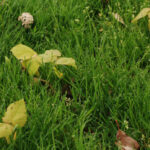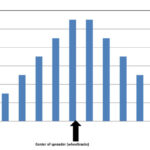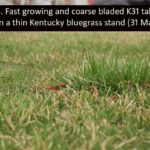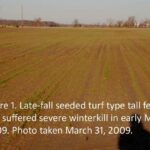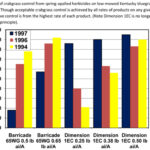Zac Reicher

Volunteer tree seedlings in lawns?
I’ve gotten a number of calls asking about volunteer maple and other tree seedlings growing in lawns. These are direct descendents of a neighborhood tree whose seed pods released last spring/summer. You can either stake a couple of these small trees and nurture them over time to become a formidable maples, or you can control […]
Gypsum as a soil amendment? Probably not
Garden centers often advertise applying gypsum to your lawn to “decompact” the soil by improving the structure of clay soil. This only works in soils common in the arid western US where there is much more sodium than calcium in the soil. This does not work in Indiana because the parent material for most of […]
Seeding into areas where preemergence herbicide was applied this spring
A fairly typical question now is, ”Can I seed into an area where preemergence herbicide was applied earlier this spring”. The answer is a very simple “No”. These herbicides are active in the soil for up to 120 days and their nature is to be absorbed into the root of a germinating weed (or turfgrass […]
Professionals Only: Spring Dandelion Control
Though fall applications are most effective for controlling broadleaf weeds, spring applications are warranted for new customers or areas that did not get treated last fall. Spring applications will be most effective if you wait until dandelions are at or near flowering, but still not as effective as fall applications. Applications before mid-April will only […]
Dandelions: Friend or Foe?
The annual bloom of dandelions is already here in southern Indiana and just around the corner in the rest of the state. Though some find dandelions attractive and some may actually eat them in salads or wine, others consider dandelions as weeds and try to control them in a lawn. The optimum time to control […]
Spacing between passes with a rotary spreader
Rotary spreaders are widely used by homeowners and professionals for most applying fertilizers and pesticides. So to test your knowledge, here’s a question that I constantly ask of professionals and do-it-yourselfers when spreading fertilizer back and forth on a turf area: A. Your current pass should spread product so it just touches the edge of the […]
Knotweed germinating next to sidewalks and other hotspots
Prostrate knotweed is currently germinating in thin areas next to sidewalks, cart paths, driveways and other hotspots. Knotweed is often confused with crabgrass at this early stage. Knotweed leaves have rounded leaf tips whereas crabgrass has leaf tips that come to a dull point (See photos). Crabgrass also has veins running lengthwise (parallel veination) whereas […]
For professionals only: Poa annua seedheads
Poa annua seedheads are just around the corner in most of Indiana and it’s high time to apply Embark or Proxy/Primo for seedhead reduction on golf courses. The seedhead models on our GDD Tracker at http://www.gddtracker.net indicate most of Indiana should be applying now. Embark and Proxy/Primo can effectively reduce seedheads of Poa annua, which tends to allow the Poa to […]
Lots of Colors in Spring Lawns
During spring green-up, lawns may reveal many variations in color, growth rate, and leaf width. This variation can be due to some of the following reasons: Species and cultivars: Perennial ryegrass is always the first of the desired cool-season grasses to green-up, followed by tall fescue and eventually Kentucky bluegrass (Fig. 1). Even within a species, […]
Winter damage in cool-season turf
I’ve gotten a number of calls on winter damage on lawns and other high mowed turf areas. Thankfully this is fairly rare in most winters throughout Indiana. Winterkill can be fairly complex resulting from desiccation with drying winds, freezing of the plant crown with quickly dropping temperatures after spring green up, and/or from direct cell […]
Turf 101: Limit Spring Fertilization
Many different strategies exist on spring fertilization, but the one fact agreed upon by all turf specialists is to avoid applying heavy nitrogen (N) rates in March or April. Heavy rates would be anything greater than 0.75 lbs of quickly available N/1000 ft2, which causes excessive shoot growth and results in frequent mowing. Furthermore, excess […]
MSMA is a “stop sale” agreement, not a “stop use”
As a follow up to the Feb. 13 Turf Tip on the new restrictions on MSMA, the Indiana Office of the State Chemist indicates this is “stop sale agreement” and not a “stop use”. Therefore, you are free to use according to the label on the actual container, any MSMA that you have in storage […]
Professionals Only: Syngenta’s Tenacity receives federal label for residential and sports turf
After much delay, Tenacity has finally received its federal label for residential and sports turf. That’s the good news, but the bad news is that state labeling is still ongoing and it won’t be for sale likely until Fall 2009 or early 2010. Experimental product is available on a limited basis from your Syngenta rep […]
Seed now to get a jump on crabgrass germination
Though spring is not our favorite time to seed, it’s important to seed as soon as possible to allow the cool-season grasses to germinate prior to crabgrass. Crabgrass germinations can occur at soil surface temperatures as low as 50F, but germination is slow and these plants (hopefully) may be killed by an ensuing frost. Most […]
Tracking Growing Degree Days for Applications? Indiana now in expanded GDD Tracker
By popular demand, we have joined with Michigan State to include Indiana sites in GDD Tracker (http://www.gddtracker.net/). This site allows you to quickly and easily check your current growing degree day accumulation. It also uses a number of models to help with decisions on timing of growth regulators for Poa annua seedheads, preemergence herbicides for crabgrass, and […]
Professionals Only: Premergence herbicide strategies
As spring is closing in, we are fielding a number of questions; four major questions right now: Which preemergnce herbide to use? That one is pretty easy. We have only three active ingredients relatively easily available and they are dithiopyr, pendimethalin, and prodiamine. Our research shows that as long as they are applied at reasonable […]
MSMA still available but use is limited
Though MSMA is rarely used by professionals anymore in cool-season turf, it is an excellent postemergent crabgrass herbicide for zoysia and bermudagrass grown in the southern half of Indiana. It is especially useful during sprigging or seeding operations because it is safe on seedlings. Following is a brief summary of the current status and the […]
Yellow nutsedge may be far off concern, but spring applications show promise
Yellow nutsedge is now one of the most common weeds in lawns, athletic fields and golf turf. Even though all textbooks say it thrives in wet areas, we see some of our worst yellow nutsedge infestations in dry years. Cultural controls will always help, but the standard herbicides are Basagran, SedgeHammer (formerly Manage), Certainty, and […]
Calculating the pounds of fertilizer to apply
There are literally thousands of fertilizers and fertilizer/pesticide combinations available to homeowners and professionals. Therefore, we can’t recommend how many pounds of a specific fertilizer to apply, but rather we must recommend fertilization rates in pounds of nitrogen per thousand square feet or lbs N/1000 sq ft. You can use our fertilizer calculator at www.agry.purdue.edu/turf/fertcalc/Fertilization%20calc.html […]
Choosing a Preemergence Herbicide
There are many, many formulations and combinations of preemergence herbicides available for the professional. Following are some suggestions for purchasing and using preemergence herbicides. Control from every preemergence herbicide can vary from year to year, or location to location. Therefore, you can’t judge the performance of a product or a specific rate of that product […]
